Experimental Study on Carbon Nanotube Heating for Li-Ion Batteries in Extremely Low-Temperature Environments
Abstract
1. Introduction
2. Experiments
2.1. Design of the CNT Sheet-Based Heating Scheme
2.2. The Design and Fabrication of the CNT Heat-Up System
2.3. Testing Setup and Procedure of the CNT Heat-Up System
3. Results and Discussion
3.1. Discharge Under 25 °C Without CNT
3.2. Discharge Under −20 °C Without CNT Heating
3.3. Discharge Under −20 °C with CNT Heating
3.4. Discharge Under −30 °C Without CNT Heating
3.5. Discharge Under −30 °C with CNT Heating
4. Conclusions
Author Contributions
Funding
Institutional Review Board Statement
Informed Consent Statement
Data Availability Statement
Acknowledgments
Conflicts of Interest
Abbreviations
| CNT | Carbon Nanotube |
| PCMs | Phase Change Materials |
| SOC | State of Charge |
| LFP | Lithium Iron Phosphate |
| TS | Temperature Sensor |
| CT | Current Transformer |
| CC | Constant Current |
References
- Somasundaram, S.; Chiam, S.Y.; Lin, M.C. Energy Storage Systems Technology Roadmap for Singapore; Nanyang Technological University: Singapore, 2020. [Google Scholar]
- Peng, X.; Chen, S.; Garg, A.; Bao, N.; Panda, B. A review of the estimation and heating methods for lithium-ion batteries pack at the cold environment. Energy Sci. Eng. 2019, 7, 645–662. [Google Scholar] [CrossRef]
- Wang, C.Y.; Zhang, G.; Ge, S.; Xu, T.; Ji, Y.; Yang, X.G.; Leng, Y. Lithium-ion battery structure that self-heats at low temperatures. Nature 2016, 529, 515–518. [Google Scholar] [CrossRef] [PubMed]
- Qu, Z.; Jiang, Z.; Wang, Q. Experimental study on pulse self-heating of lithium-ion battery at low temperature. Int. J. Heat Mass Transf. 2019, 135, 696–705. [Google Scholar] [CrossRef]
- Zhang, J.; Ge, H.; Li, Z.; Ding, Z. Internal heating of lithium-ion batteries using alternating current based on the heat generation model in frequency domain. J. Power Sources 2015, 273, 1030–1037. [Google Scholar] [CrossRef]
- Hu, X.; Zheng, Y.; Howey, D.A.; Perez, H.; Foley, A.; Pecht, M. Battery warm-up methodologies at subzero temperatures for automotive applications: Recent advances and perspectives. Prog. Energy Combust. Sci. 2020, 77, 100806. [Google Scholar] [CrossRef]
- DuBeshter, T.; Jorne, J. Pulse Polarization for Li-Ion Battery under Constant State of Charge: Part I. Pulse Discharge Experiments. J. Electrochem. Soc. 2017, 164, E3539. [Google Scholar] [CrossRef]
- Ji, Y.; Wang, C.Y. Heating Strategies for Li-Ion Batteries Operated from Subzero Temperatures; The Electrochemical Society: Pennington, NJ, USA, 2012. [Google Scholar]
- Jaguemont, J.; Boulon, L.; Dubé, Y. A comprehensive review of lithium-ion batteries used in hybrid and electric vehicles at cold temperatures. Appl. Energy 2016, 164, 99–114. [Google Scholar] [CrossRef]
- Lei, Z.; Zhang, Y.; Lei, X. Temperature uniformity of a heated lithium-ion battery cell in cold climate. Appl. Therm. Eng. 2018, 129, 148–154. [Google Scholar] [CrossRef]
- Li, W.; Qu, Z.; He, Y.; Tao, Y. Experimental study of a passive thermal management system for high-powered lithium ion batteries using porous metal foam saturated with phase change materials. J. Power Sources 2014, 255, 9–15. [Google Scholar] [CrossRef]
- Yang, X.-G.; Liu, T.; Wang, C.-Y. Innovative heating of large-size automotive Li-ion cells. J. Power Sources 2017, 342, 598–604. [Google Scholar] [CrossRef]
- Review of the North American Lithium Forklift Battery Market: The 7 Most Popular Brands in the USA and Canada. Available online: https://www.onecharge.biz/blog/review-of-the-north-american-lithium-forklift-battery-market-the-7-most-popular-brands-in-the-usa-and-canada/ (accessed on 20 March 2022).
- Yan, J.; Wang, C.Y. Heating strategies for Li-ion batteries operated from subzero temperatures. Electrochim. Acta 2013, 107, 664–674. [Google Scholar]
- Xu, F.; Aouraghe, M.A.; Xie, X.; Zheng, L.; Zhang, K.; Fu, K.K. Highly stretchable, fast thermal response carbon nanotube composite heater. Compos. Part A Appl. Sci. Manuf. 2021, 147, 106471. [Google Scholar] [CrossRef]
- Chiew, J.; Chin, C.; Toh, W.; Gao, Z.; Jia, J. Thermal state-of-expansion or melting of phase change material based heat sink for underwater battery power system. J. Energy Storage 2019, 26, 100956. [Google Scholar] [CrossRef]
- Gao, Z.; Chin, C.S.; Chiew, J.H.K.; Jia, J.; Zhang, C. Design and Implementation of a Smart Lithium-Ion Battery System with Real-Time Fault Diagnosis Capability for Electric Vehicles. Energies 2017, 10, 1503. [Google Scholar] [CrossRef]
- Chiew, J.; Chin, C.; Toh, W.; Gao, Z.; Jia, J.; Zhang, C. A pseudo three-dimensional electrochemical-thermal model of a cylindrical LiFePO4/graphite battery. Appl. Therm. Eng. 2019, 147, 450–463. [Google Scholar] [CrossRef]
- DyNano-Pyroabnd Specification. Available online: www.douyee.com.sg (accessed on 20 March 2022).
- Pop, E.; Varshney, V.; Roy, A.K. Thermal properties of graphene and carbon nanotubes. Nano Res. 2012, 5, 239–260. [Google Scholar]
- Berber, S.; Kwon, Y.-K.; Tomanek, D. Unusually high thermal conductivity of carbon nanotubes. Phys. Rev. Lett. 2000, 84, 4613. [Google Scholar] [CrossRef] [PubMed]
- Kumanek, B.; Janas, D. Thermal conductivity of carbon nanotube networks: A review. J. Mater. Sci. 2019, 54, 7397–7427. [Google Scholar] [CrossRef]
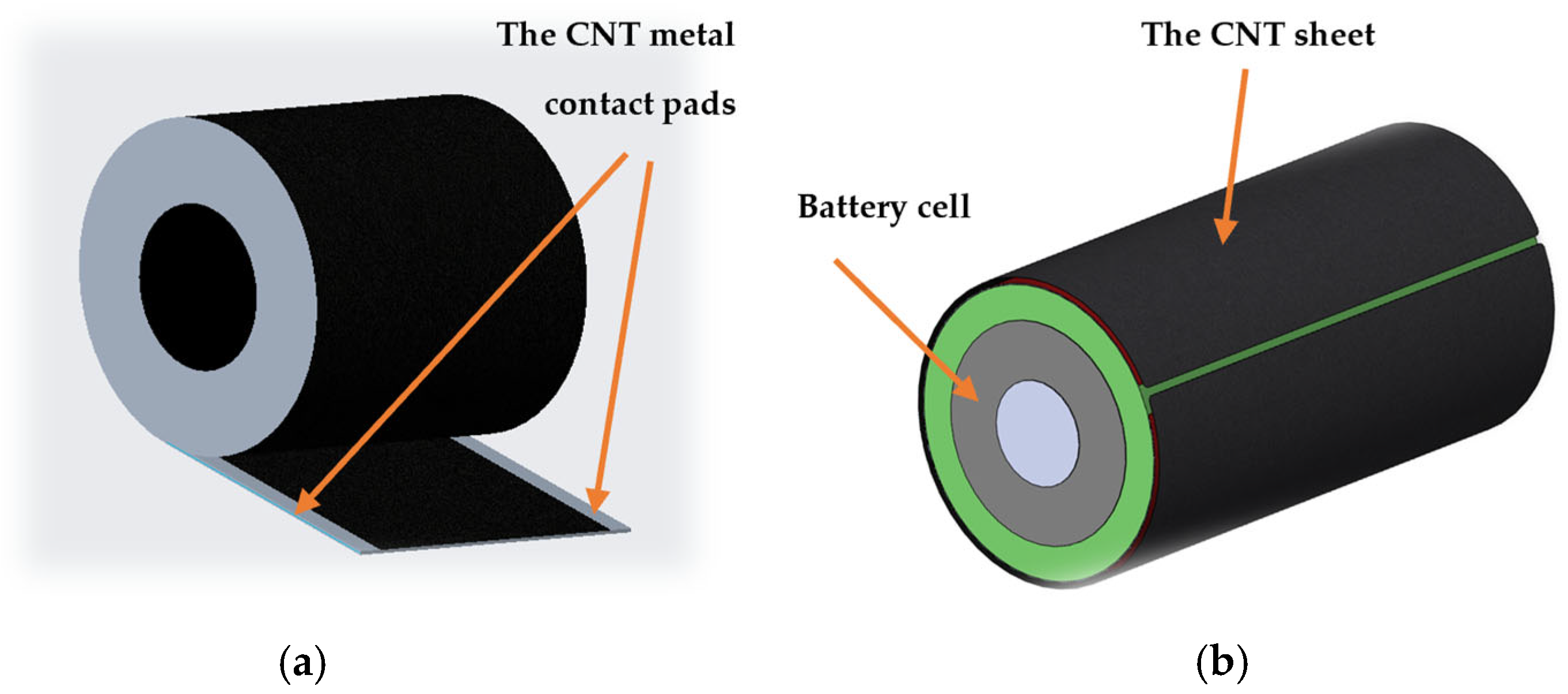
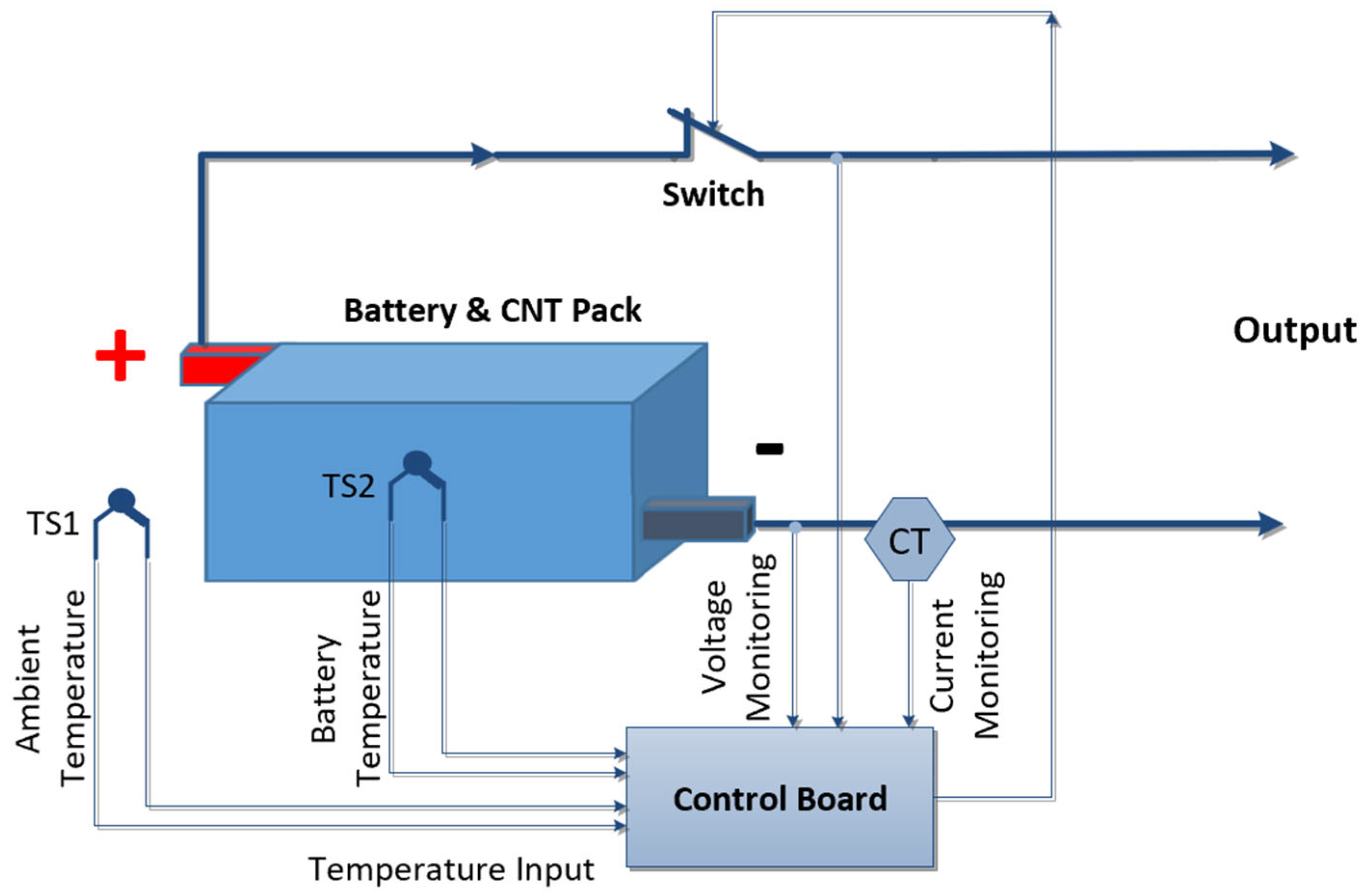
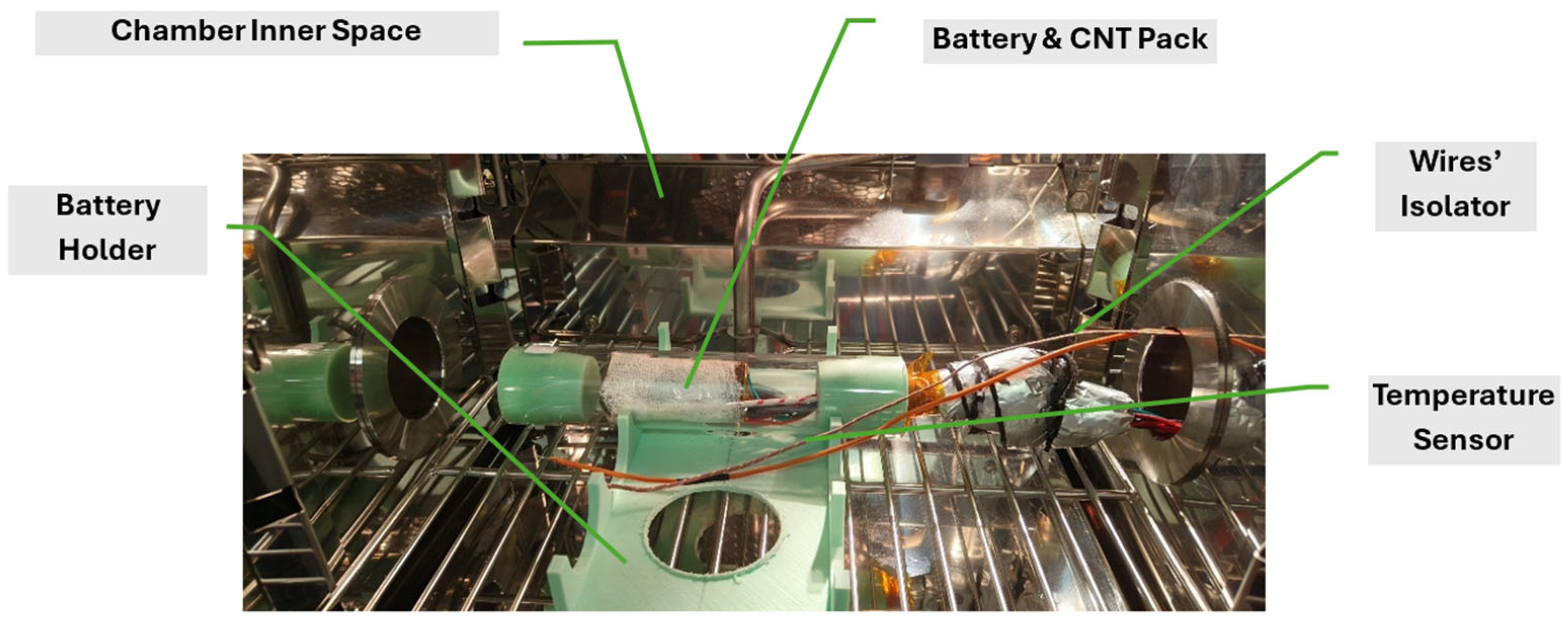

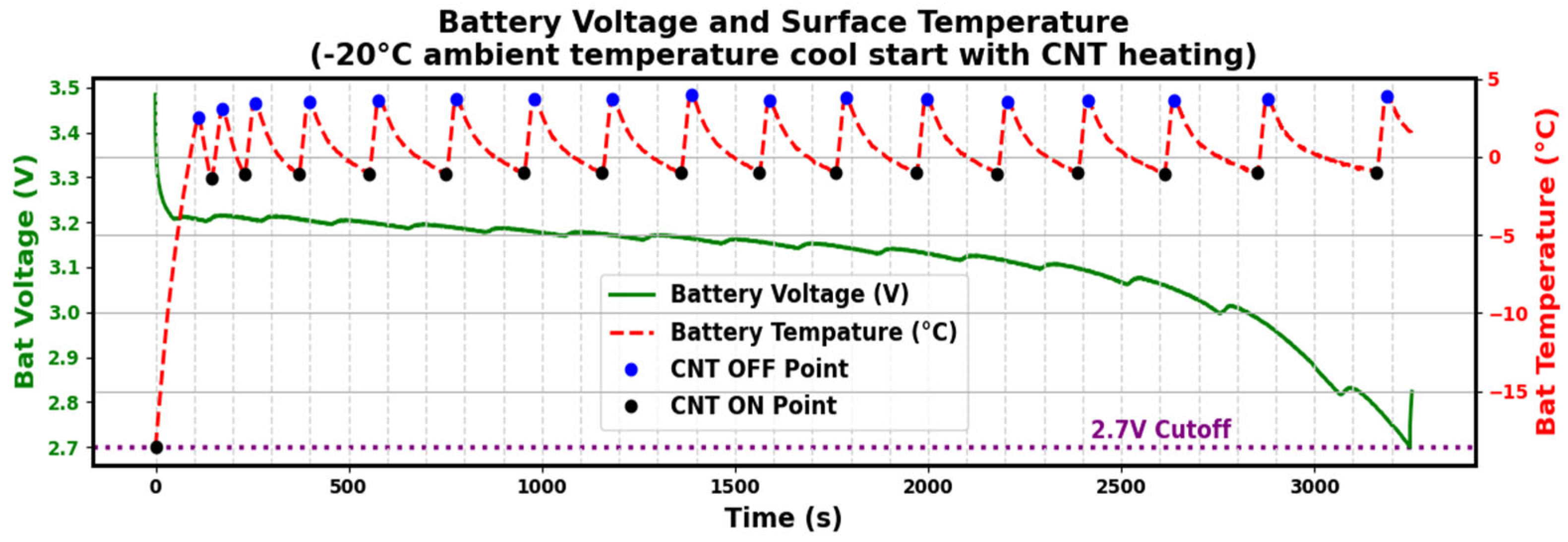



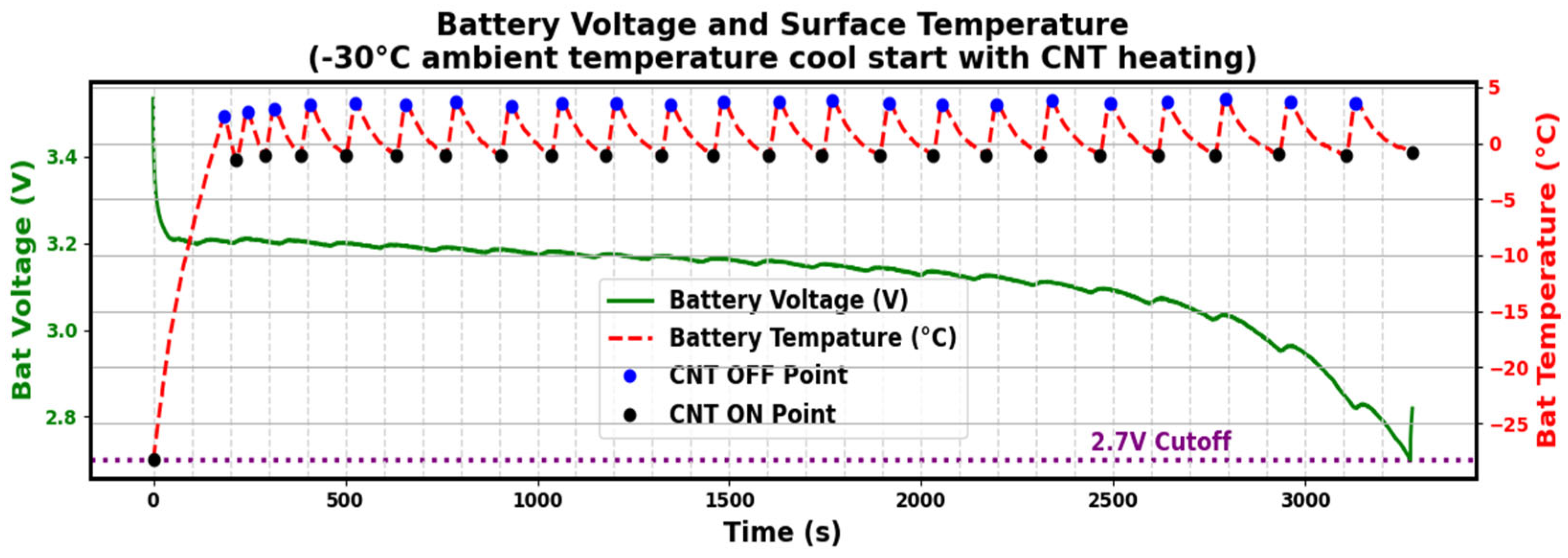
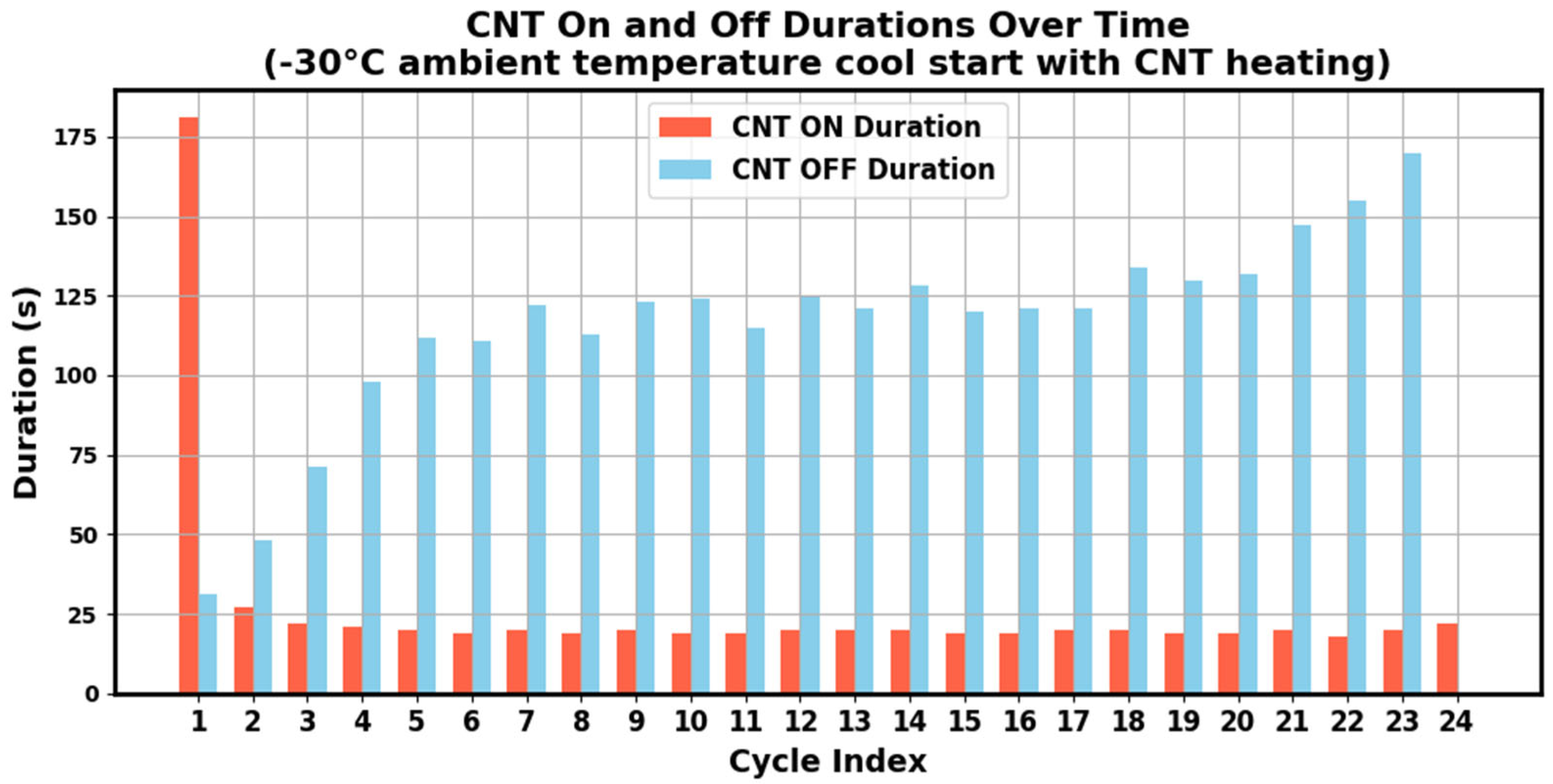
| Classification | Sub-Class | Advantages | Disadvantages | |
|---|---|---|---|---|
| Passive method | PCM-based thermal management | It does not consume energy to heat battery packs. PCMs store and release heat when it melts or freezes at the given condition. |
| |
| Active method | Internal heating | Self-internal heating | It does not require an additional heat transfer system or circuit components, which enables its low cost and high reliability. Most research is performed in this area. |
|
| AC heating | One of the most efficient preheating approaches, which can heat the battery quickly and uniformly. | The cell resistance inconsistency gives rise to different heat generation rates inside each cell and thus causes a temperature gradient inside the battery module/pack. | ||
| Mutual pulse heating |
| Requires specially designed circuits and control systems, which significantly increase the cost when the battery is at a high SOC level, considering the effect of lithium plating. | ||
| A nickel foil is embedded inside a cell | The existing internal heating methods can heat the battery in a fast way. |
| ||
| Convective heating | Internal convective heating | Thermal field is more even. | Requires a closed system, including flow channels, heaters, fans, and batteries, while ensuring minimal heat loss. | |
| External convective heating |
|
| Battery Type | LFP |
|---|---|
| Cell Dimensions | φ26 × 65 mm |
| Cell Weight | 76 g |
| Cell Capacity (nominal/minimum) | 2.50/2.40 Ah |
| Voltage (nominal) | 3.3 V |
| Internal Impedance (1 kHz AC typical) | 6 mΩ |
| Cycle Life at 20 A Discharge, 100% DOD | >1000 cycles |
| CNT Sheet | Typical Features |
|---|---|
| Thickness | 20 µm |
| Resistance | 110 Ω |
| Thermal conductivity | >2000 W/mK |
| Dimensions | 200 (Length) × 65 (Width) mm |
| Key Items | Parameters |
|---|---|
| Chamber Temperature | 25 °C |
| Discharge Mode | Constant Current (CC) |
| Discharge Current | 1 C at 2.50 A |
| Capacity Output | 2.50 Ah |
| Energy Output | 8.00 Wh |
| Cutoff Voltage | 2.70 V |
| Duration of the Discharge | 3625 s |
| Operation Condition | Startup Time (s) | Capacity Output (Ah) | Energy Output (Wh) |
|---|---|---|---|
| 25 °C | - | 2.50 | 8.00 |
| −20 °C without CNT heating | - | 1.585, (63.4%) | 4.60, (57.5%) |
| −20 °C with CNT heating | 97 | 2.25, (90%) | 7.09, (88.6%) |
| −30 °C without CNT heating | - | 0.03, (1.2%) | 0.082, (1.02%) |
| −30 °C with CNT heating | 141 | 2.25, (90%) | 5.84, (73.0%) |
Disclaimer/Publisher’s Note: The statements, opinions and data contained in all publications are solely those of the individual author(s) and contributor(s) and not of MDPI and/or the editor(s). MDPI and/or the editor(s) disclaim responsibility for any injury to people or property resulting from any ideas, methods, instructions or products referred to in the content. |
© 2025 by the authors. Licensee MDPI, Basel, Switzerland. This article is an open access article distributed under the terms and conditions of the Creative Commons Attribution (CC BY) license (https://creativecommons.org/licenses/by/4.0/).
Share and Cite
Jia, J.; Wang, G.; Gao, Z.; Han, M. Experimental Study on Carbon Nanotube Heating for Li-Ion Batteries in Extremely Low-Temperature Environments. Energies 2025, 18, 2958. https://doi.org/10.3390/en18112958
Jia J, Wang G, Gao Z, Han M. Experimental Study on Carbon Nanotube Heating for Li-Ion Batteries in Extremely Low-Temperature Environments. Energies. 2025; 18(11):2958. https://doi.org/10.3390/en18112958
Chicago/Turabian StyleJia, Junbo, Gucheng Wang, Zuchang Gao, and Ming Han. 2025. "Experimental Study on Carbon Nanotube Heating for Li-Ion Batteries in Extremely Low-Temperature Environments" Energies 18, no. 11: 2958. https://doi.org/10.3390/en18112958
APA StyleJia, J., Wang, G., Gao, Z., & Han, M. (2025). Experimental Study on Carbon Nanotube Heating for Li-Ion Batteries in Extremely Low-Temperature Environments. Energies, 18(11), 2958. https://doi.org/10.3390/en18112958






